- Leadership Pulse
- Posts
- Healthcare Investments and Entrepreneurship in Sub-Saharan Africa: 2025 Outlook.
Healthcare Investments and Entrepreneurship in Sub-Saharan Africa: 2025 Outlook.
Welcome to Leadership Pulse!
Merry Christmas!
Every week, I share actionable strategies and lessons from my experiences as a healthcare leader, entrepreneur, and angel investor.
This newsletter equips readers with insights for creating lasting impact, whether navigating leadership challenges, building cohesive teams, or scaling a startup.
Table of Contents
Introduction
The healthcare landscape in Sub-Saharan Africa is rapidly evolving, presenting challenges and opportunities for investors and entrepreneurs.
With a growing population, increased demand for healthcare services, and a surge in digital innovations, 2025 will be a pivotal year for healthcare investment and entrepreneurship in the region.
This week’s newsletter explores the key sectors, opportunities, and strategies for navigating this dynamic environment.
The State of Healthcare in Sub-Saharan Africa
Sub-Saharan Africa is home to over 1.2 billion people, and its healthcare system struggles to meet the needs of its population.
Despite economic growth and increasing health expenditure, the region faces significant challenges, including:
Inadequate Infrastructure: Many healthcare facilities lack basic amenities and modern equipment.
Workforce Shortages: The region has some of the lowest healthcare worker-to-patient ratios globally.
High Disease Burden: Communicable diseases like malaria, HIV/AIDS, and tuberculosis persist alongside a rising tide of non-communicable diseases (NCDs) such as diabetes and hypertension.
Access Barriers: Geographic, financial, and systemic barriers limit access to care for many populations.
These challenges, however, also create opportunities for transformative investment and entrepreneurship.
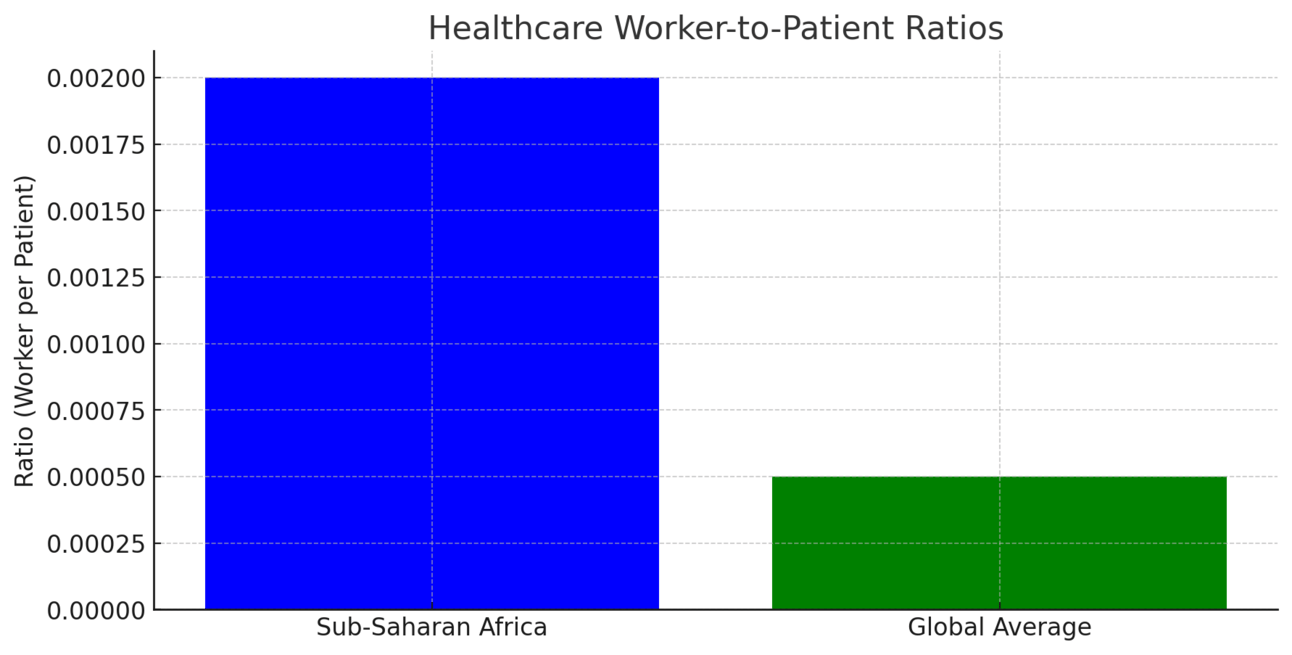
Bar Graph: Displays healthcare worker-to-patient ratios in Sub-Saharan Africa compared to the global average.
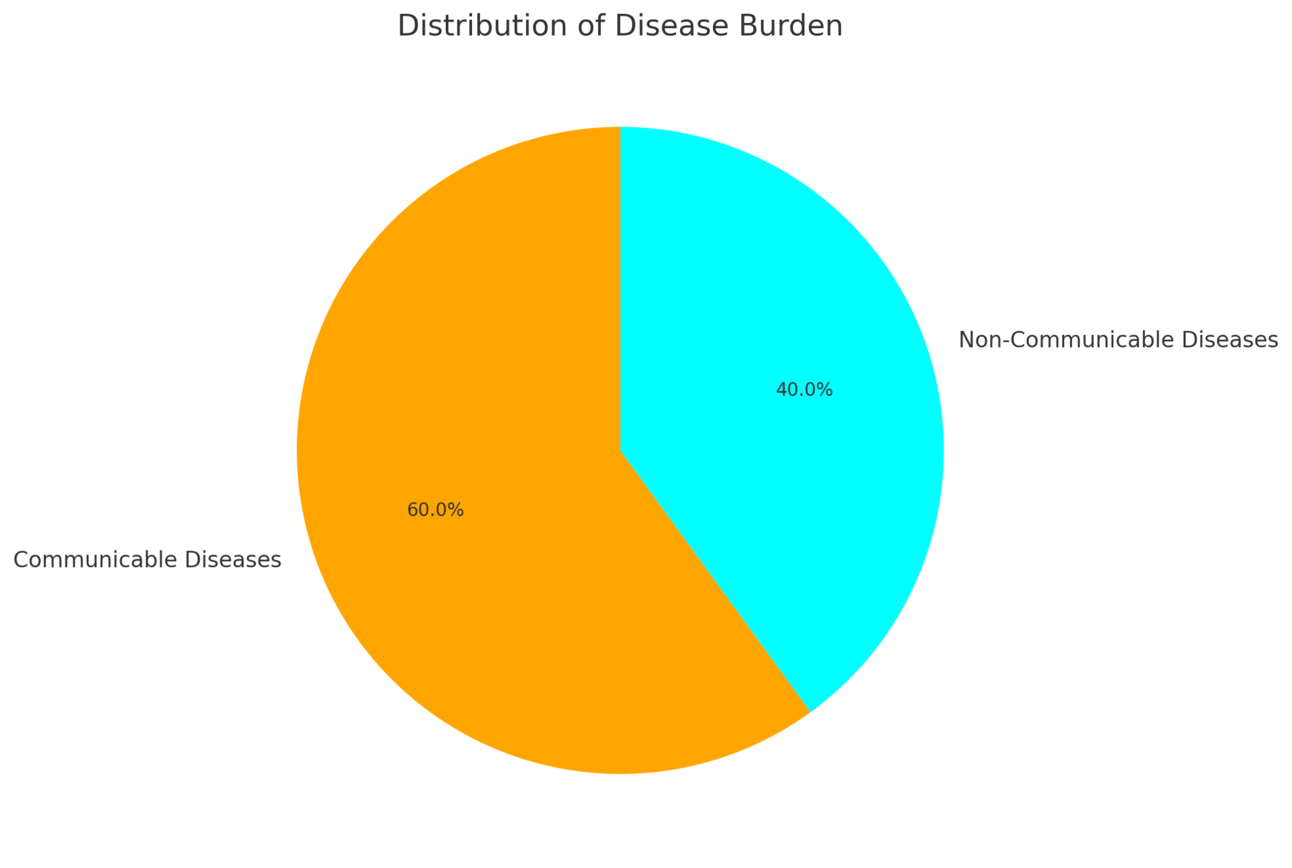
Pie Chart: This chart illustrates the distribution of the disease burden, with 60% for communicable diseases and 40% for non-communicable diseases.
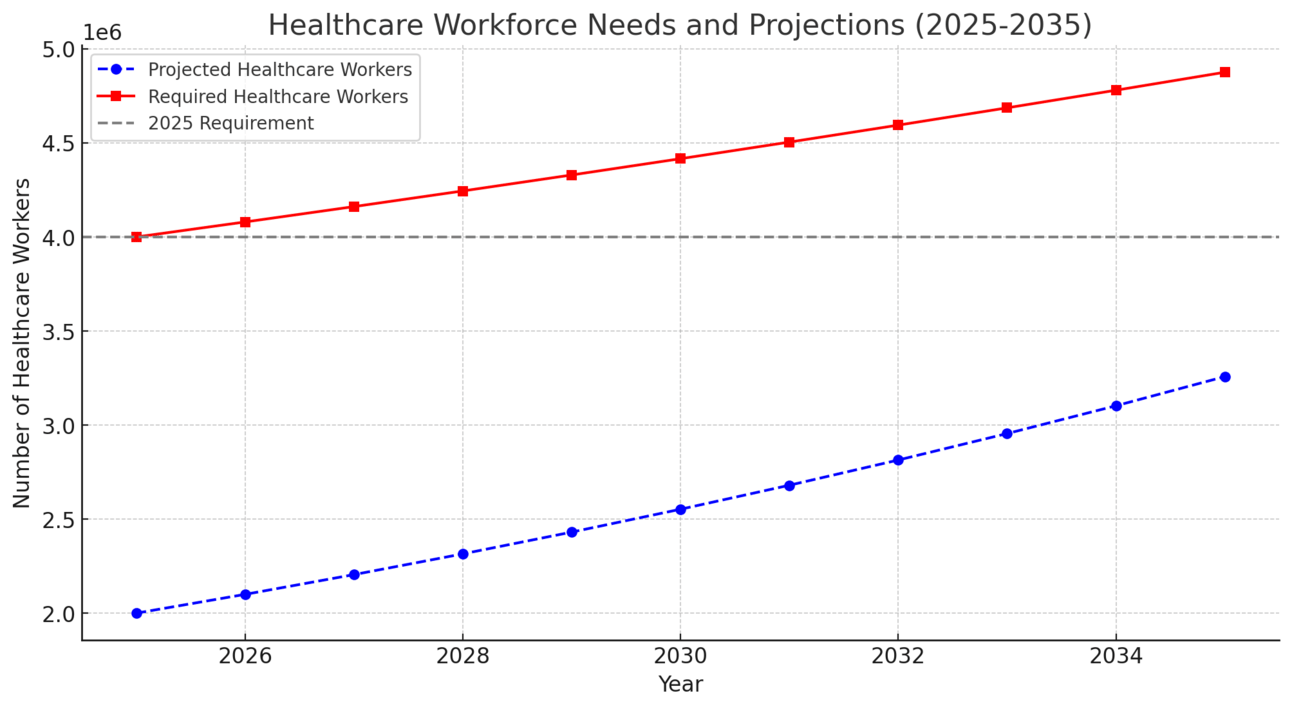
This graph visualizes the projected growth of healthcare workers in Sub-Saharan Africa (2025-2035) compared to the estimated workforce requirements:
Blue Line: Projected growth of healthcare workers based on a 5% annual growth rate.
Red Line: Increasing workforce requirements, assuming a 2% annual rise in demand.
Gray Line: The initial workforce requirement in 2025 as a baseline.
Emerging Trends in 2025
Several trends are shaping the healthcare landscape in Sub-Saharan Africa:
Digital Health and Telemedicine:
The adoption of digital health solutions continues to accelerate. Platforms offering teleconsultations, e-pharmacies, and remote diagnostics are bridging access gaps.
Examples: Startups like Helium Health (Nigeria) and mPharma (Ghana) are pioneering industrial health innovations.
Primary Healthcare Strengthening:
Governments and NGOs are focusing on building resilient primary healthcare systems to address both communicable and non-communicable diseases.
Health Fintech:
Health insurance and microfinance innovations are enabling low-income populations to access healthcare services.
Example: Companies like Reliance Health (Nigeria) offer affordable health insurance plans.
Biotech and Pharmaceuticals:
There is a growing interest in local pharmaceutical manufacturing to reduce import dependency and improve drug availability.
Public-Private Partnerships (PPPs):
Collaboration between governments and private entities creates new infrastructure development and service delivery avenues.
Focus on Maternal and Child Health:
Maternal and child health investments are regaining traction, driven by a commitment to achieving the Sustainable Development Goals (SDGs).
Key Investment Opportunities
Telemedicine and Digital Health Platforms:
The widespread adoption of mobile phones and internet access provides a fertile ground for digital health solutions. Investors can explore startups focusing on teleconsultations, health education, and remote monitoring.
Strategy: Partner with telecom companies to ensure affordable data access and scalability.
Pharmaceutical Manufacturing:
Sub-Saharan Africa imports approximately 70-90% of its pharmaceuticals. Investing in local manufacturing facilities can address supply chain vulnerabilities and create significant returns.
Strategy: Leverage incentives like tax breaks and public-private partnerships to reduce production costs and ensure market access.
Healthcare Infrastructure:
The demand for modern healthcare facilities is immense. From hospitals to diagnostic centres, I can partner with governments or explore Build-Operate-Transfer (BOT) models.
Strategy: Identify underserved regions and collaborate with local governments to secure land and subsidies.
Healthcare Technology (HealthTech):
Innovations in affordable diagnostic devices and AI-driven tools present opportunities for improving diagnostics and patient outcomes.
Strategy: Develop low-cost, portable diagnostic tools targeting rural and remote areas.
Health Insurance Solutions:
With a significant portion of the population uninsured, pervasive health insurance models that target low-income groups are needed.
Strategy: Use mobile platforms to deliver micro-insurance products and ensure flexible payment options.
Mental Health Services:
Mental health remains underfunded and underserved in the region. Startups offering counselling, therapy, and awareness campaigns have untapped potential.
Strategy: Partner with schools, workplaces, and religious organizations to provide community-based mental health services.
Specialized Care Centers:
To address the increasing prevalence of NCDS, centres should be established in interdisciplinary fields, such as radiology, cardiology, or orthopaedics.
Strategy: Collaborate with international healthcare providers to access expertise and cutting-edge technology.
Logistics and Supply Chain Innovations:
Reliable supply chains are critical for delivering medicines and vaccines.
Strategy: Invest in cold chain logistics and last-mile delivery solutions, including drones and GPS-enabled tracking systems.
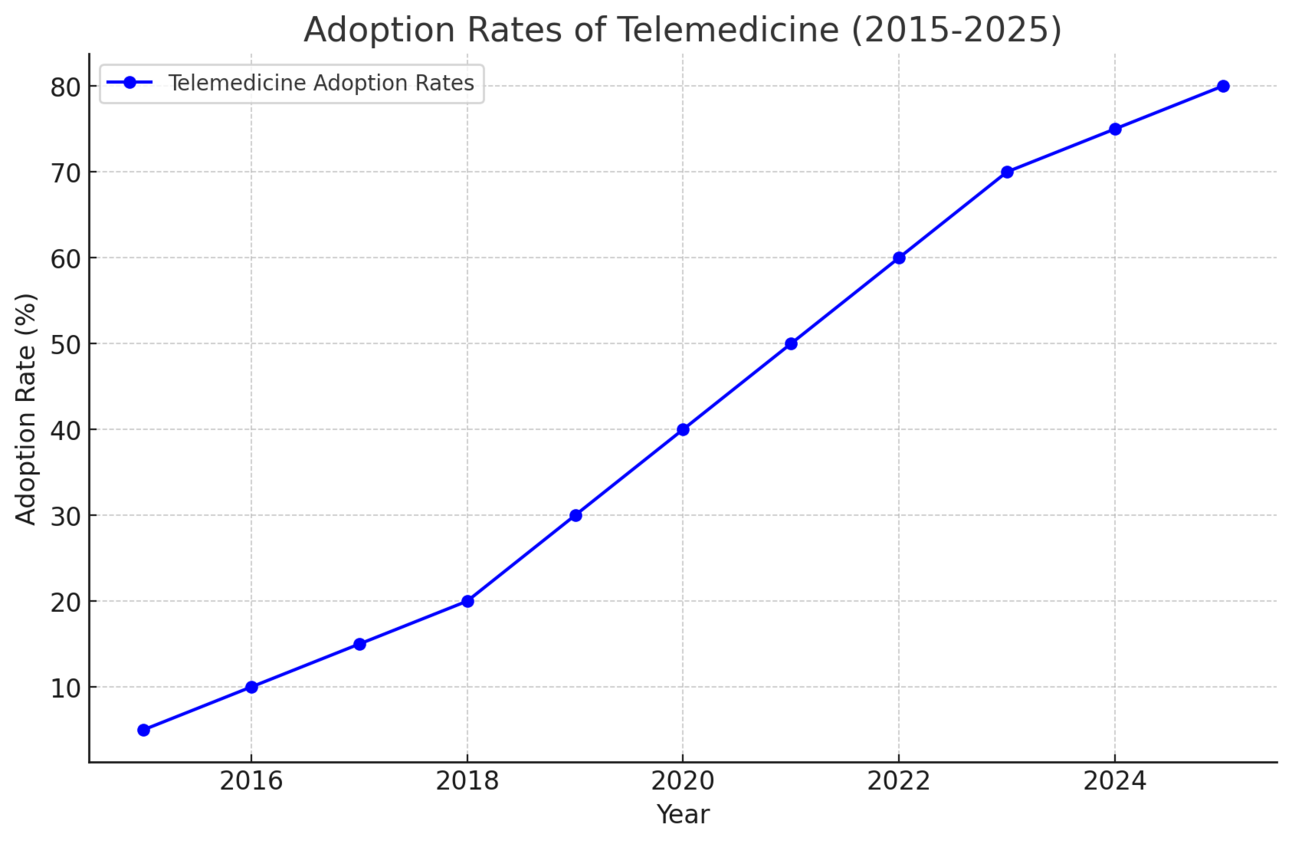
Line Graph: Depicting telemedicine adoption rates from 2015 to 2025, showing a steady increase.
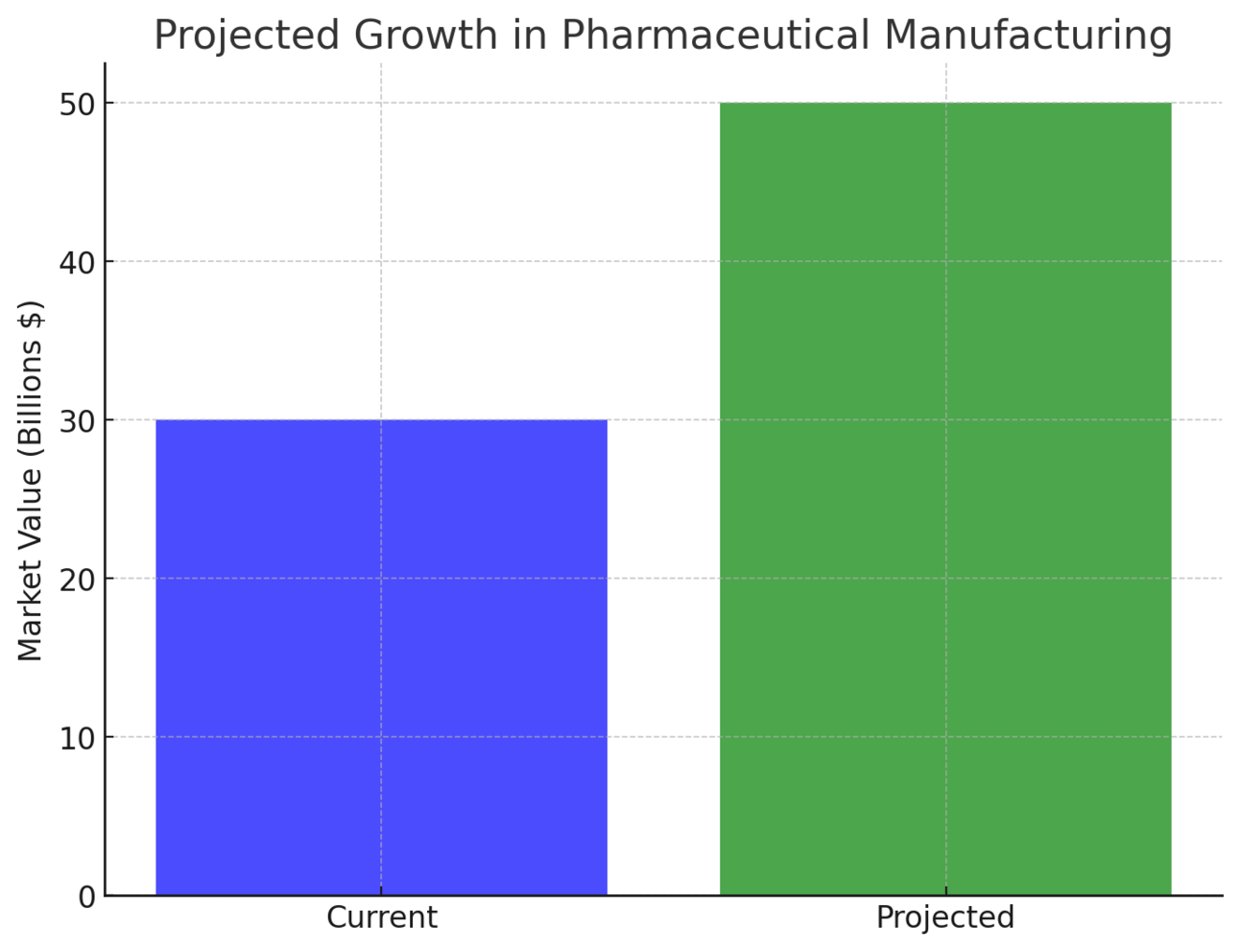
Bar Chart: Highlighting the projected growth in pharmaceutical manufacturing, comparing the current market value to future projections.
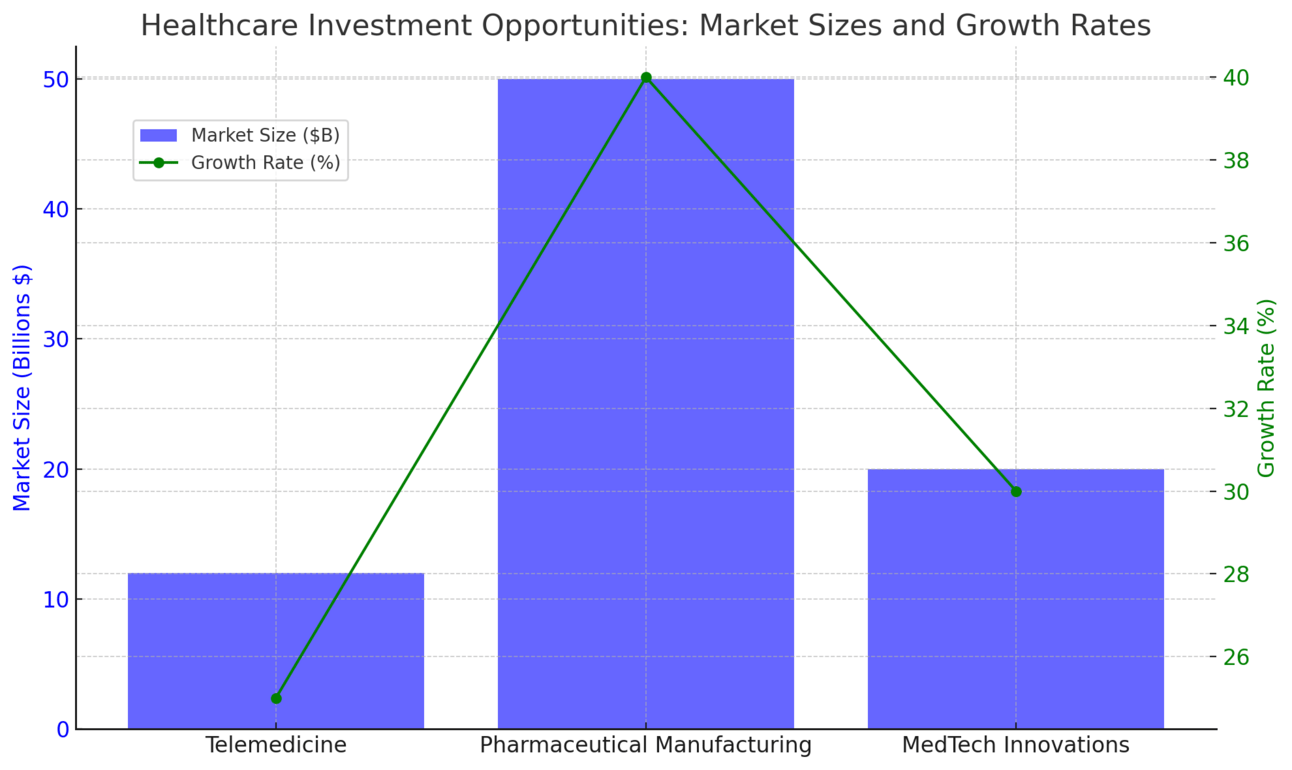
This visualization presents a summary of the top healthcare investment opportunities in Sub-Saharan Africa:
Blue Bars: Market sizes in billions of dollars for telemedicine, pharmaceutical manufacturing, and MedTech innovations.
Green Line: Projected growth rates for each sector, indicating a high potential for expansion.
Entrepreneurial Strategies for 2025
For healthcare entrepreneurs, the following strategies can help navigate the landscape:
Understand Local Context:
Tailor solutions to address specific health challenges and cultural nuances of the region.
Adapt health education campaigns to local languages and customs.
Leverage Technology:
Incorporate digital tools to enhance scalability and efficiency. For instance, AI can be used for diagnostics, and blockchain can be used for secure health records.
Build Strong Partnerships:
Collaborate with governments, NGOs, and private sector players to leverage resources and expand reach.
Partner with community health workers to improve trust and adoption of new services.
Focus on Sustainability:
Ensure that solutions are financially and environmentally sustainable.
Use solar-powered equipment in off-grid areas to reduce operational costs.
Embrace Data-Driven Decision-Making:
Use health data and analytics to inform business strategies and improve service delivery.
Case Studies: Success Stories in Sub-Saharan Africa
mPharma (Ghana):
Focus: Affordable medications through a network of pharmacies.
Impact: Operating in multiple countries, mPharma has improved access to essential medicines for millions.
Key Strategy: Leveraged technology to optimize drug procurement and inventory management.
Zipline (Rwanda):
Focus: Drone delivery of medical supplies.
Impact: Zipline has revolutionized the delivery of blood and vaccines to remote areas.
Key Strategy: Partnered with government agencies to scale operations.
Helium Health (Nigeria):
Focus: Electronic medical records and hospital management systems.
Impact: Empowering healthcare providers with digital tools to streamline operations.
Key Strategy: Targeted urban and peri-urban hospitals with scalable software solutions.
Investment Risks
Investing in healthcare in Sub-Saharan Africa comes with risks, including:
Regulatory Challenges:
Navigating complex and varied regulatory environments across countries can be daunting.
Infrastructure Gaps:
Limited infrastructure can hinder project implementation and scalability.
Political Instability:
Political and economic instability in some countries poses risks to investment.
Cultural Barriers:
Misaligned interventions that do not consider local cultural practices can face resistance.
To mitigate these risks, investors and entrepreneurs should conduct thorough due diligence, engage local stakeholders, and adopt adaptive business models.
The Role of Policy and Advocacy
Policymakers play a crucial role in shaping the healthcare investment climate.
Key areas for advocacy include:
Strengthening Regulatory Frameworks:
Clear and consistent regulations can foster investor confidence.
Incentives for Local Manufacturing:
Tax breaks and subsidies can encourage pharmaceutical and MedTech production.
Investments in Workforce Development:
Training and retaining healthcare workers is essential for sustainable growth.
Support for Innovation:
Governments can establish innovation hubs and provide funding for startups.
Looking Ahead: The Future of Healthcare in Sub-Saharan Africa
The healthcare sector in Sub-Saharan Africa is at a crossroads.
The region can overcome challenges and unlock its potential with strategic investments and innovative entrepreneurship.
Key drivers of future growth include:
Youthful Population:
A young, tech-savvy population will drive demand for modern healthcare solutions.
Global Collaboration:
Partnerships with international organizations can bring expertise and funding to the region.
Technological Advances:
AI, robotics, and biotechnology will redefine healthcare delivery.
Increased Awareness:
Growing health and wellness awareness will spur demand for preventive and curative services.
Conclusion
Healthcare investments and entrepreneurship in Sub-Saharan Africa in 2025 offer a mix of challenges and opportunities.
By focusing on innovation, sustainability, and collaboration, stakeholders can make a significant impact while achieving financial success.
Whether you are an investor seeking high-growth opportunities or an entrepreneur driven by a mission to transform lives, the time to act is now.
Partner with Me for Impact:
Executive Coaching for Healthcare Leaders:
Tailored strategies to help you lead effectively in uncertain environments.Healthcare Consulting Services:
Insights on enhancing operational efficiency, regulatory compliance, and patient care outcomes.Advisory for Healthcare Startups:
Support with scaling strategies, investor pitching, and navigating healthcare regulations.
Let’s connect!
Reply to this email or find me on LinkedIn, and let’s discuss how I can help you achieve your goals.
Are you loving Leadership Pulse?
Please share this email with a colleague or friend.
Together, let’s build a stronger community!
Testimonials:
“Subscribe to Ikechukwu’s newsletter. It is amazing”.- Tolu Ekwe
Stay Connected:
Yours in leadership,
Ikechukwu Okoh
Reply